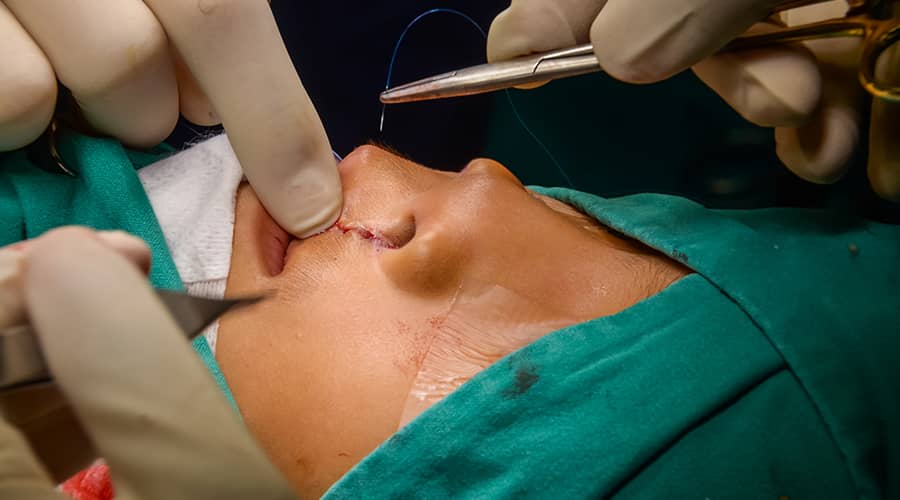
The following information is provided to assist you in after care for cleft surgery. If you have any questions regarding any of this information, please ask your doctor.
Swelling
It is normal to experience swelling of the lip and cheek region after cleft repair. The swelling will be more significant on the cleft side and may also cause puffiness of that eye. The facial swelling will begin to decrease after three days. An ice pack should be applied to the cheek(s) region 48 hours after surgery. The head should be elevated on two pillows when sleeping or napping to help minimize swelling.
Pain
Your child will experience pain from the cleft surgery and the iliac crest bone graft donor site. The iliac crest site is generally more uncomfortable than the cleft site. Children respond well to ibuprofen (Children’s Advil, for example). Follow the directions on the bottle for dosing information. You may use the prescription pain medication as directed on the bottle for pain that does not respond to ibuprofen.
Bleeding
A small amount of bloody ooze from the mouth or nostril is common. Please contact our office if your child experiences a sustained nose bleed that has not stopped after 10 minutes. There will be a dressing on the iliac crest donor site. You may notice a small patch of blood on the dressing; this is expected and should cause no concern. Please contact our office if the dressing becomes saturated with blood.
Diet
Only clear liquids should be taken the evening following surgery. The diet may be advanced to full liquids the following day. Do not use a straw for three weeks. After returning home and for the first two weeks after surgery, the diet is restricted to very soft foods that do not require chewing. Foods with the consistency of mashed potatoes are appropriate during this time. Your child should not bite off solid food with their front teeth until three weeks after surgery.
Sutures
There will be sutures in the mouth. Some of these will dissolve, but a couple must be removed approximately 10-14 days after surgery. The iliac crest donor site only has sutures under the skin. Steri-strips are in place to hold the skin edges together during healing. The steri-strips will fall off after 2-3 weeks.
Bathing
The iliac donor site must be kept dry for ten days. After ten days, your child may shower. No tub baths, swimming in pools, lakes, or the ocean until three weeks after surgery.
Oral Hygiene
Good oral hygiene is essential for adequate healing and preventing infection. You should supervise your child’s tooth brushing on the day following surgery and after each meal. Brushing should be done with a soft child’s toothbrush, being careful to only make direct contact with the teeth in the cleft area. Do not brush the sutures. It is very important to keep the mouth clean as the wounds heal.
You will be given a bottle of Chlorhexidine mouth rinse from the hospital, begin using it the night of surgery after brushing and flossing. This mouth rinse should be used twice daily, after breakfast and before bed, until gone. Rinse for at least 30 seconds before spitting it out. Do not drink or eat food for 15 minutes after using the mouth rinse.
You may also rinse with 1/2 a teaspoon of salt in a cup of warm water six times a day. Continue to do this until the healing process is over. Do not use a water pik for 2 weeks after surgery.
Remember: Keeping the wound clean will ensure it heals better and faster.
Dressings
The dressing covering the iliac crest donor site will be removed at the first clinic visit after surgery. The dressing must not get wet; however, it should be removed if it does. Do not remove the steri-strips under the dressing, even if they are wet.
Antibiotics
Take the prescribed antibiotics as directed to help prevent infection. If you experience a rash or an unfavorable reaction to the antibiotic, discontinue use and notify our office. Otherwise, be sure to complete the entire course of treatment. If you experience an upset stomach, we recommend taking acidophilus or a pro-biotic along with your antibiotic.
Antibiotics may make oral contraceptives less effective. You should use an alternate form of birth control while on a course of antibiotics.
Activity Restrictions
For three weeks after surgery, your child should not use a straw or blow their nose. Your child may walk with assistance on the evening of surgery. For six weeks after surgery, your child should not run, jump, ride a bicycle or skateboard, rough-house or participate in any sports or PE at school.
Questions/Problems
We want your recovery to be smooth and pleasant. Following these instructions will ensure the best possible outcome. Please call the office if you have any questions or concerns about your progress. If your child develops a fever (>100.4), bleeding, nausea, or swelling in the mouth, preventing fluid intake, please contact our office. We are available 24 hours a day.
Thank you for trusting us with your oral and maxillofacial surgery needs.
Call Us